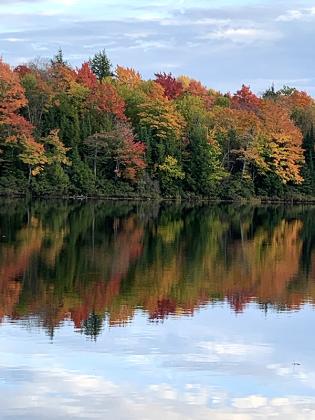Taken at the James Lake boat landing on Sept. 25.
By Bill Cook
The annual color change makes autumn the favorite season for many.
While gorgeous, it’s part of a much longer physiological and ecological process of tree survival during a harsh season.
Hiking through southern Alger County in mid-September revealed the first signs of leaf color change in the maples. Those shallow, rather infertile soils urge the trees to quit the season a bit earlier than other places. Trees along the Lake Superior shore have milder microclimates and often change colors later than anywhere else in the U.P.
The balsam poplars have already lost most of their annual battles with leaf diseases, with the browning leaves already on the descent. Ashes, what’s left of them, after emerald ash borer debacle, were next. The black ash, in particular, yellows, then browns, then drops earlier than most other tree species. The bigtooth aspen are beginning to drop their characteristic crimson and gold leaves.
Oak leaves will persist longer. Sugar maple is a stickler for punctuality. The brown leaves of beech and ironwood will stick to the twigs well into winter, sometime obscuring the views across freshly fallen snow.
The very last to go will be the tamaracks, nearer to the end of October and into early November. Their golden yellow is spectacular. These are my favorite. They live outside the normal boundaries and break rules.
The timing of leaf color change is relatively consistent, as it is controlled by a balance between dark and light hours. This window is roughly ten days to two weeks from the end of September and into the middle of October. Tree species comply, more or less, with their biological clocks, but not every species uses the same clock.
In late August, red maples along our highways often cause comments about an early color change. These trees are responding to unfavorable growing conditions rather than the onset of an early fall.
There is a lot of biochemistry related to the annual undressing of the forest. The especially valuable elements get pulled into storage. The magnesium heart of the chlorophyll molecule is a good example. As the green chlorophyll molecules break down, other colors appear. But, that’s not the entire story.
Should the first hard frost happen while the leaves retain good stocks of sugars, we should usually see a better color show. An early hard frost can predict a particularly glamorous color season. Color intensity is also a function of tree health and September temperatures.
A late frost and mild fall temperatures bode for a more demure display, but still spectacular.
While timing is largely controlled by photoperiod, the intensity and visual quality of the fall colors can be impacted by weather. The compounds with red, yellow, and purple pigments may be brighter, or persist for a little longer, with warm days and frosty nights. But it’s a risky business to predict color change patterns.
The process is part of what trees undergo to make themselves hardy for the cold and dryness of winter. Northern trees have some astounding and mind-blowing adaptations.
The geography and expansive forest of the Lake States provides some of the most colorful fall displays in the world. Annual treks by thousands of leafpeepers provide testimony to this fact.
It is a good time to be in the woods, as bird hunters will quietly attest.
Much of our hardwood, or broad-leaf, forest consists of maples, aspens and oaks. We eagerly anticipate the flaming explosion of maples, which usually outperforms the color changes in other parts of the continent. Our aspens also turn a lively yellow color, especially with the right weather conditions. The bigtooth aspen appear to have more reds than yellows in some years. Oaks exhibit deep purple when the frosts come early. A bright yellow canopy over a snow-white paper birch stand is an experience not soon forgotten.
But, let us not ignore the softwoods or evergreens. Although they do retain needles year-round, they don’t retain them all. The older needles, nearer to the trunk, fall off every year. The yellow-brown internal needles of red and white pine are, perhaps, the most obvious. The only exception is the glorious tamarack, which loses all their needles. One last toast to the revered fall.
Once again, the much-anticipated season of color change will soon lie behind us. This time of year, many of us hold our breath, lest we miss those few days when the forest canopy alights with the fire and brilliance of the last hurrah of the summer.
Every season hosts a multitude of changes in the forest and all that lives there, including us humans. Fall color is arguably the favorite of all seasonal changes and without doubt the outdoors is teeming with interesting events this time of the year.


